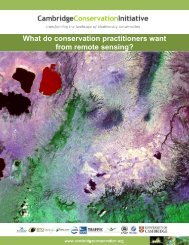CONSERVING BIODIVERSITY & DELIVERING ECOSYSTEM SERVICES
conserving biodiversity & delivering ecosystem services
conserving biodiversity & delivering ecosystem services
You also want an ePaper? Increase the reach of your titles
YUMPU automatically turns print PDFs into web optimized ePapers that Google loves.
In 2011, an expert consultation indicated that the supply<br />
of harvested wild goods, including food, fibre, fuelwood<br />
and natural medicines, was likely to be decreasing at over<br />
half of the IBAs that deliver these as one of the most<br />
important services. Around one-third of sites showed an<br />
increase in this service. Recreation and tourism is<br />
reportedly on the increase at 95% of IBAs where it occurs.<br />
There is also a reported increase in supply of cultivated<br />
foods at some sites although this is likely to be at the<br />
expense of other services. Global climate regulation is<br />
believed to be stable or increasing across most of the sites,<br />
as is water provision (see figure).<br />
Proportion of IBAs delivering ecosystem services with increasing,<br />
stable or decreasing trends over the past five years<br />
Numbers in brackets represent the number of sites at which the service was recorded as<br />
being the 5 most important. Only these sites are included in each column, and only<br />
services that were important at >5 sites are presented.<br />
SOURCE Based on information provided at an expert consultation workshop.<br />
Local stakeholders discuss the changes to habitats and impacts<br />
on ecosystem services occurring at Koshi Tappu Wildlife Reserve<br />
over recent years (Jenny Birch)<br />
A similar exercise with local stakeholders at Rara National Park<br />
(David Thomas)<br />
An example from Koshi Tappu Wildlife Reserve IBA<br />
Koshi Tappu Wildlife Reserve is an IBA and Ramsar site in the Terai of south-east Nepal. A mosaic of open water, riverine<br />
habitats and seasonally flooded grasslands, it supports tens of thousands of waterbirds and is also important for the<br />
globally threatened Ganges River Dolphin and home to Nepal’s last population of wild Asian Water Buffalo. However, since<br />
the 1990s the number of waterbirds visiting the reserve has dropped dramatically.<br />
“Wetland species undoubtedly face the greatest threats in Nepal. One example is Black-bellied tern which occurs on lakes and<br />
rivers in the lowlands, and which has all but disappeared from Koshi, as a result of widespread food shortages” says Top Khatri,<br />
National Programme Manager for the ‘Conservation and Sustainable Use of Wetlands in Nepal’<br />
project. “The food of the tern—fish—is also an important resource for people, particularly those from<br />
poorer communities, and the birds are indicating that this important resource is diminishing. To reduce the<br />
conflict between livelihood needs and conservation objectives, we need to develop sustainable options that<br />
can deliver material benefits to local people whilst preserving the ecological integrity of the wetlands”.<br />
For more details of this study, see p.29.




